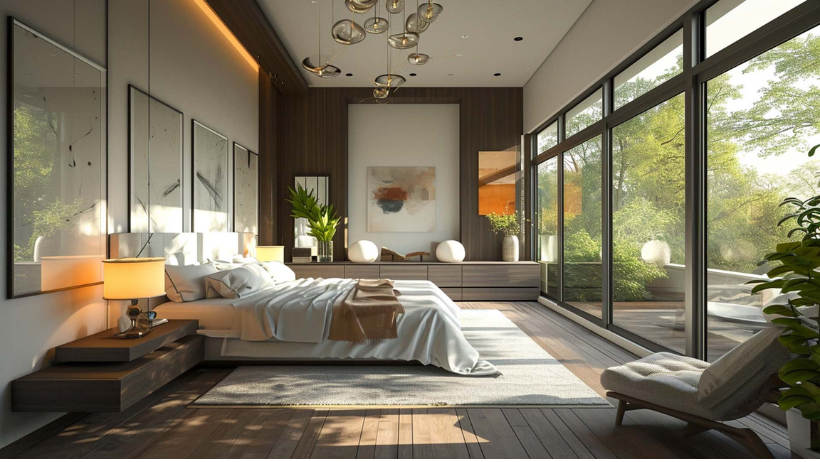Interior design is all about turning ideas into real, livable spaces. That transformation—from concept to finished room—used to take weeks. But now, thanks to AI rendering, designers can visualize and adjust their ideas in a fraction of the time.
This post explores how AI rendering is reshaping modern interior design, making workflows faster, smarter, and more creative.

What Is AI Rendering?
AI rendering uses artificial intelligence to speed up and improve the process of creating visual outputs. It enhances traditional rendering by learning from large datasets, predicting lighting, and filling in details.
Unlike classic engines, AI tools can offer results in seconds. Some even turn sketches into lifelike interiors instantly.
Why AI Rendering Matters in Interior Design
Designers need to explore options. AI lets them test colors, layouts, and lighting fast.
With AI:
- Clients see results sooner
- Revisions take minutes, not hours
- Designers have more room to experiment
Because of that, it is now a key part of interior design workflows.
Key Benefits of AI Rendering in Interior Design
Let’s break down the major advantages.
1. Speed
Traditional rendering may take hours per image. AI can cut that to minutes or even seconds.
Faster previews help designers try new ideas quickly. This leads to better final outcomes.
2. Real-Time Iteration
Changes in layout or lighting can be previewed right away. You don’t have to wait for re-renders.
This real-time feedback loop makes collaboration smoother.
3. Accessibility
AI-powered tools are often more user-friendly. Even non-experts can generate renders from simple inputs.
That opens doors for small teams or freelance designers.
4. Cost Efficiency
Less render time means less hardware cost. Designers can use mid-range devices and still get great results.
AI rendering also lowers the need for big in-house render farms.
5. Photorealism with Less Effort
AI models trained on real-world photos can simulate natural lighting and materials better.
This creates more convincing images, perfect for client presentations.
How AI Rendering Fits in the Interior Design Workflow
Here’s how a modern workflow might look:
- Concept Sketch: Start with hand-drawn sketches or digital drafts.
- AI Enhancement: Use AI tools to create a first draft render.
- Client Feedback: Share the render, gather comments.
- Quick Edits: Tweak layout, colors, lighting using AI.
- Final Render: Generate a high-quality version for the presentation or portfolio.
With each phase sped up by AI, designers can finish more projects in less time.
Popular AI Rendering Tools for Interior Designers
Here are some platforms making waves:
1. Interior AI
Turn floorplans or rough inputs into full-room visualizations. Good for early-stage ideas.
2. PromeAI
Sketch to render tool that gives you quick concept visuals. Helps in mood boarding.
3. DALL·E + Photoshop
Generate decor elements or textures with prompts. Then blend them into your space design.
4. Midjourney or Stable Diffusion
Ideal for concept art or lighting studies. These tools are helpful for pitching ideas.
5. Autodesk Revit + Enscape AI Denoising
Used in architecture and design. Revit integrates well with plugins that boost real-time performance.
Challenges of Using AI Rendering
While powerful, AI isn’t perfect yet. Designers should watch for:
- Inconsistent geometry in AI-generated outputs
- Limited control over details
- Need for manual cleanup in final files
Still, as tools improve, these limits will shrink.
Best Practices for Designers Using AI Rendering
To get the most out of AI rendering:
- Combine AI tools with traditional 3D software
- Use real-world references to guide outputs
- Start with clean floorplans and lighting guides
- Don’t skip post-processing for final renders
AI boosts speed, but your eye still guides the art.
Trends: Where AI Rendering Is Heading
AI in interior design is growing fast. Some trends include:
- Personalized design assistants that learn your style
- Voice-to-render tools for quick ideation
- AI material editors for realistic surfaces
- Real-time AR previews for clients using phones
Designers who embrace these trends stay ahead of the curve.
>>> Read more: 3D Asset Optimization Techniques: Faster Renders & Lighter Files
Render Smarter with 3S Cloud Render Farm
Even with AI, complex scenes still need strong rendering power. That’s where 3S Cloud Render Farm helps.
With support for Blender, Maya, Cinema 4D, and more, you can upload your AI-enhanced scene and render it in minutes.
👉 Start rendering with 3S Cloud Render Farm
Conclusion
AI is changing how interior designers work. It brings speed, flexibility, and new creative freedom.
By using these tools wisely, designers can spend more time designing—and less time waiting.
Now is the time to explore AI rendering. Combine it with powerful platforms like 3S Cloud, and take your interior design projects from concept to reality—faster than ever.